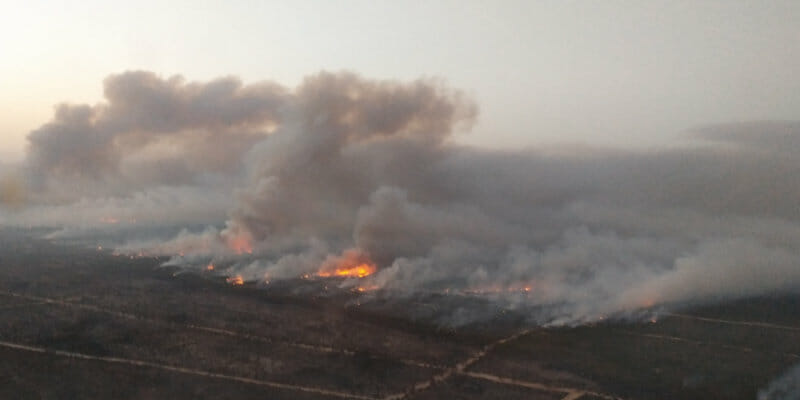Even If We Limit Global Warming, Fire and Drought Will Remain Threats
The most limited rise in global temperatures—never mind higher ones—is going to exact a price. A 2017 wildfire in Spain. (Cear2002 / Wikimedia Commons)
A 2017 wildfire in Spain. (Cear2002 / Wikimedia Commons)
The most limited rise in global temperatures, never mind higher ones, is going to exact a price through fire and drought. Even assuming the world keeps to its Paris promise to contain average planetary temperature increases to “well below 2°C” by 2100, drought conditions in China will intensify ten or 20-fold, according to new research.
And even if this warming, driven by ever increasing emissions of greenhouse gases from burning coal, oil and gas, is held to the implicit ambition of no more than 1.5°C above the average for most of human history, the area charred by wildfires each summer in Europe could increase by 40%, according to a separate study.
If the temperatures continue to rise to as much as 3°C by the century’s end, the area covered by charred foliage and smoking tree trunks could rise by 100%.
The temperature targets are important because 195 nations agreed in 2015 at a UN conference in Paris to limit greenhouse gas emissions and hold planetary average temperatures to if possible 1.5°C and certainly no more than 2°C.
3°C in prospect
In the last century or so, increasing ratios of carbon dioxide in the planet’s atmosphere have lifted average temperatures by about 1°C already, and although almost all nations have announced plans to switch to solar and wind power for future energy sources, and to restore the forests that absorb carbon, the world still seems on course for a rise to 3°C by the end of the century.
Politicians and climate sceptics argue that action to contain global warming will be expensive. But over and over again, climate science research continues to demonstrate that inaction could be even more expensive.
China is now the world’s largest emitter of greenhouse gases. Scientists from China, Poland and Germany report in the Proceedings of the National Academy of Sciences that they used computer simulations and a range of climate change forecasts to model what could happen to rainfall and vegetation in China over the next 80 years, and then tried to calculate the effect on China’s developing economy.
Between 1949 and 2017, drought affected crops over an area of more than 2 million square kilometres – this is one sixth of the country’s arable land. And between 1984 and 2017, direct economic losses reached more than $7bn a year, at 2015 prices.
“Limiting global warming to 1.5°C can strongly reduce the increase of burned area”
If the temperature stabilises at a 1.5°C increase, losses compared to the period 1986-2005 will increase tenfold. Compared to the immediate past of 2006-2015, the study estimates that losses will still rise threefold. And should the temperature go beyond 1.5°C to 2°C, average drought loss could double again.
Studies such as these simply match what has happened in the past with what could happen in the future – always provided that things continue as they seem to be proceeding now. The studies can deliver only very broad-brush outlines of the shapes of things to come.
Higher average temperatures will mean ever more pronounced extremes of drought and rainfall, and a study earlier this year warned that, in China alone, catastrophic flooding as a consequence of climate change could cost the country $380bn over the next 20 years.
Europe, too, the same study argued, would suffer significant losses as a consequence of climate change. Another such study in 2017 estimated that climate change – and the attendant hazards of flood, drought, wildfire and heatwaves – could threaten 350 million Europeans every year.
Consistent pattern
Forest and scrub fires char on average about 4,500 square kilometres of Mediterranean Europe every year: in 2017, there were damaging blazes in France, Italy, Portugal and Spain, with human casualties and extensive ecological and economic losses.
Now new research led by Spanish scientists and reported in the journal Nature Communications uses computer simulations and available data to take a look at the fires next time, as the temperatures rise.
The authors warn that even though there are large uncertainties in such projections, there is also a consistent pattern: the higher the temperatures, the more sustained the droughts, and the larger the areas that will be incinerated.
They do offer a palliative solution, though. “Limiting global warming to 1.5°C can strongly reduce the increase of burned area,” they say.
Your support matters…Independent journalism is under threat and overshadowed by heavily funded mainstream media.
You can help level the playing field. Become a member.
Your tax-deductible contribution keeps us digging beneath the headlines to give you thought-provoking, investigative reporting and analysis that unearths what's really happening- without compromise.
Give today to support our courageous, independent journalists.






You need to be a supporter to comment.
There are currently no responses to this article.
Be the first to respond.